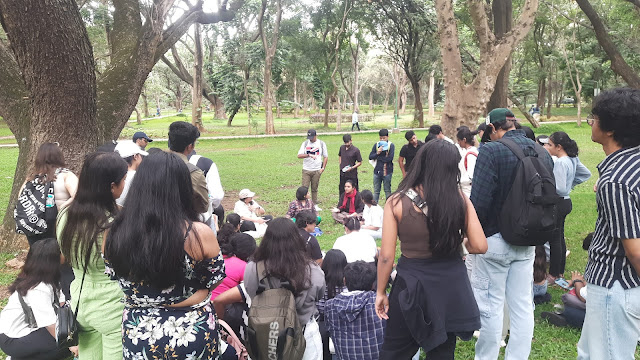A Journey of Insight and Inspiration
As a hydrogeologist by profession, my world revolves around the mysteries and mechanics of water - a crucial element shaping our planet's future. Recently, I had the delightful opportunity to guide a group of bright, third-year architecture students from Balwant Sheth School of Architecture, part of the NMIMS Deemed to be University Campus in Vile Parle, Mumbai, through the lush expanse of Cubbon Park in Bengaluru.
Tracing History
Our journey began with a dive into history. I unfolded the tale of how Cubbon Park, originally a small strip of land eventually grew into 100 acres to its current expanse of 197 acres. The park was named after the longest-serving Commissioner of Mysore state, Mark Cubbon.
The historical Attara Kacheri, dating back to 1864, was our first stop. This is where the park originated. Inspired by Aurangzeb's governance style and created by Devaraja Wadiyar II, this '18-department secretariat' stands as a testament to Bengaluru's rich past. When the Attara Kacheri was built, the area surrounding the building was barren, undulating, rapidly sloping several gravel pits and rocky (Which is the natural topography of Bengaluru). But back then, they perceived these as blemishes and tried to cover the barren topography with trees and plants to make the surroundings green and lush and there my friend The Cubbon Park was born.
Rocks Telling Stories
Our exploration took us to a remarkable geological landmark - a 3500-million-year-old rock outcrop, the base rock of Bengaluru, part of the granitic Gondwana Peninsula Gneiss Complex. Standing there, we felt the pulse of the earth beneath our feet.
The Aquifer's Tale
Next, we delved into the heart of hydrogeology. The park, with its 75 recharge wells and 7 open wells, served as a perfect model to discuss Bengaluru's shallow and deep aquifers. We discussed their functions, benefits, and how to utilize them efficiently for a sustainable future.
An intriguing aspect was a Kalyani (a well within a well), offering a unique look at ancient water conservation techniques.
Lessons from an Open Well
A highlight was an open well brimming with water, juxtaposed with a defunct borewell. This stark contrast illustrated the efficiency, cost-effectiveness, and lower carbon footprint of shallow aquifers compared to deeper, more energy-intensive alternatives.
Cultural Connections: The Karaga Festival
Deep Dive into Karaga
One of the most vibrant parts of our tour was discussing the Karaga festival, a dazzling folk festival of Karnataka with deep historical and cultural significance.
Origins and Symbolism
The festival, rooted in the epic Mahabharata, is particularly connected to Draupadi, known locally as Droupadmma. It represents her journey through trials and tribulations, symbolizing strong and ideal womanhood.
The Karaga Ritual
Central to the festival is the Karaga pot, a mud pot topped with a tall floral pyramid, carried on the priest's head. This pot, filled with water and adorned with decorations, remains a revered and mysterious element of the festival.
The Significance
This festival, occurring in the heart of the city, is not just a religious event but a cultural spectacle, weaving together community, tradition, and reverence for water. It serves as a reminder of the city's rich cultural heritage and its intrinsic connection to water.
Sustainable Water Management in Cubbon Park
The Park's Thirst and Sustainability
Our tour concluded with a visit to the Sewage Treatment Plant (STP) and discussions about the water demand of the park. This segment highlighted the importance of sustainable urban planning and water management in city landscapes and innovative Water Solutions
We discussed the park’s approach to water management, including its use of treated wastewater for irrigation and collaborations for reducing water costs and consumption.
Future Plans: The park aims to expand its network for more treated water, moving towards a sustainable model that reduces freshwater usage and cost.
This field visit was more than a mere walk in the park. It was an enlightening journey connecting the past, present, and future of water management. For these budding architects, understanding the nexus of water, demand, supply, and climate change is crucial. They are the harbingers of change, poised to design water-resilient cities and foster a sustainable future.
As we parted ways, I saw in their eyes a newfound appreciation for the role they play in shaping a world where water sustainability and resilience are not just concepts, but the cornerstones of our survival.
Visit Dated: 22nd November 2023
~ Ayushi



.png)

.png)